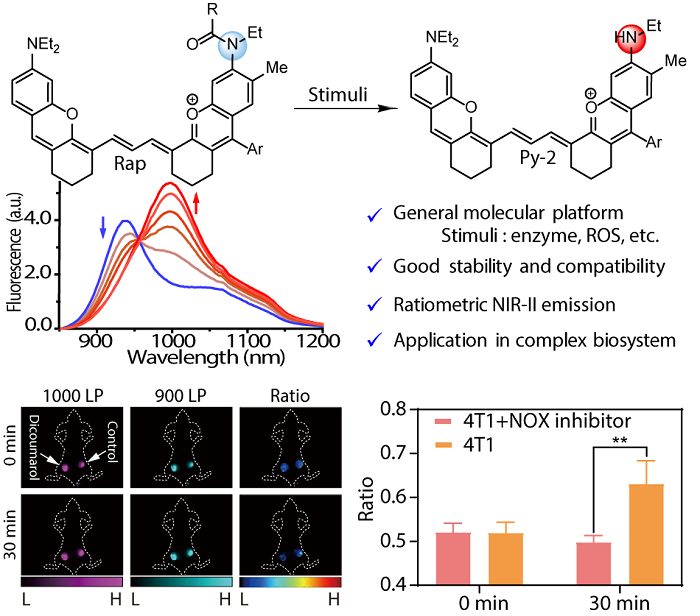
Lei Zuhai's research group at the School ofPharmacy has made progress in the field of fluorescence biosensing in the second near-infrared window (NIR-II). The research project constructed a NIR-II molecular platform, which can be conveniently developed for various activatable ratiometric NIR-II molecular fluorescent probes for the reliable detection of specific targets within deep tissue with high resolution. The results were published at JACS under the title of Polymethine Molecular Platform for Ratiometric Fluorescent Probes in the Second near-Infrared Window.
Noninvasive optical imaging in the NIR-II region has attracted increasing attention due to its deep biological tissues penetration depth and reduced background autofluorescence. Currently, off-on type NIR-II probesare the most numerous class of NIR-II fluorescent probes. They can be selectively activated by specific substrates both in vitro and in vivo but cannot be used to quantitatively detect target molecules. Compared with off-on probes, ratiometric probes are more accurate and reliable for quantitative or semiquantitative biosensing with its built-in self-calibration function. However, up to now, only a few ratiometric NIR-II fluorescent probes were reported and most of these probes are limited to monitoring reactive small molecules. A general strategy to construct a ratiometric NIR-II molecular probe is still lacking.
Recently, Lei’s group reported a molecular platform named Py-2 by integrating the rhodamine 6G scaffold and polymethine, which can be conveniently modified to ratiometric NIR-II molecular fluorescent probes. After acetylation of the amino group on the Py-2, it was found that the absorption spectrum of Py-2 was blue shifted and emission was still maintained. Therefore, a ratiometric NIR-II molecular fluorescent probe can be constructed by adjusting the intramolecular charge transfer (ICT) properties of the amino group. To verify the universality of the platform molecules, the ratiometric fluorescent probes Rap-N and Rap-R were synthesized in response to nitroreductase and ROS/RNS, respectively. Both probes showed an excellent ratio of fluorescence response to specific substrates. In vivo experiments showed that Rap-N achieved semi-quantitative monitoring of nitroreductase in different tumors, and Rap-R achieved real-time monitoring of liver injury and peritonitis.

Response mechanism of the probe and its application in tumor hypoxic imaging
In summary, this work reported a ratiometric NIR-II molecular fluorescent probe platform Py-2 which has good general applicability. Based on this platform, they constructed two ratiometric fluorescent probes and realized the reliable monitoring of enzymes, ROS/RNS in living deep tissues. As a molecule platform, Py-2 can be conveniently developed for various activatable ratiometric NIR-II molecular fluorescent probes for the reliable detection of specific targets within deep tissue with high resolution.
The first authors are postdoctoral fellow Lan Qingchun and PhD student Yu Peng from Fudan University. The corresponding author is Youth Researcher Lei Zuhai. This work was supported by the School of Pharmacy of Fudan University, the Key Laboratory of Smart Drug Delivery (Fudan University), Ministry of Education, the National Natural Science Foundation of China, Shanghai Science and Technology Commission and the start-up funds of Fudan University.
Link to original article. https://pubs.acs.org/doi/full/10.1021/jacs.2c10041